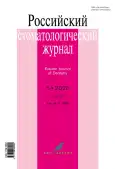Interactive teaching methods in dentistry in post-graduate education, as a condition for stimulating cognitive activity
- 作者: Musaev U.Y.1, Rizaev J.A.1
-
隶属关系:
- Samarkand State Medical Institute
- 期: 卷 24, 编号 5 (2020)
- 页面: 306-311
- 栏目: Organization of Healthcare Service
- URL: https://journals.rcsi.science/1728-2802/article/view/61029
- DOI: https://doi.org/10.17816/1728-2802-2020-24-5-306-311
- ID: 61029
如何引用文章
全文:
详细
The article presents new materials about active and interactive teaching methods in improving the quality and modernization of the modern medical education system. The information about the objects of research and innovative technologies of interactive training in the specialty “therapeutic dentistry” is presented. The stages of organizing an interactive educational process are outlined with the outlook for the knowledge gained, as well as improving the organization of the control system for teaching and mastering practical skills, organizing and conducting for the first time a master class with training in Uzbekistan, congresses and international scientific and practical conferences with the invitation of foreign dentists.
作者简介
U. Musaev
Samarkand State Medical Institute
编辑信件的主要联系方式.
Email: musaev_ulugbek84@mail.ru
乌兹别克斯坦, 140100, Samarqand, Amir Temur str., 18
J. Rizaev
Samarkand State Medical Institute
Email: musaev_ulugbek84@mail.ru
乌兹别克斯坦, 140100, Samarqand, Amir Temur str., 18
参考
- Gadaev AG, Gulyamova ShS. Modern pedagogical technologies in the organization of the educational process in the clinical departments of medical universities. Tashkent; 2011. (in Russian)
- Artyukhina AI, Chumakov VI. Interactive teaching methods in a medical university. Volgograd: Publishing House of Volgograd State Medical University; 2012. (in Russian)
- Dyachkova MG. Modernization of the system of higher and additional professional education of specialists with medical and pharmaceutical education. Moscow; 2019. (in Russian)
- Bordovskaya NV, editor. Modern educational technologies. 2nd ed. Moscow: KNORUS; 2011. (in Russian)
- Zhurakovsky V, Fedorov I. Modernization of higher education: problems and solutions. Vysshee obrazovanie v Rossii. 2006;(1):3–14. (in Russian)
- The system of continuing medical education (NMO). Moscow: Forum Media; 2016. (in Russian)
- Zairatyants OV. Reform of continuing medical education and certification (accreditation) of doctors. Moscow; 2016. (in Russian)
- Zelensky IV, Zelensky VI. The modern system of continuing medical education and admission to the specialty. Glavnyi vrach Yuga Rossii. 2018;(6):35–37. (in Russian)
- Stupina SB. Technologies of interactive learning in higher school. Saratov: Nauka; 2009. (in Russian)
- Artyukhina AI, Chumakov VI. Interactive teaching methods in a medical. Volgograd; 2011. (in Russian)
- Protasova IN, Podgrushnaya TS, Peryanova OV, et al. The role of active teaching methods in the formation of professional and personal competence of a future doctor. Fundamental'nye issledovaniya. 2013;(8–5):1208–1211.(in Russian)
- Innovative technologies in the educational process of a medical university. St. Petersburg: SPbGMA; 2006. (in Russian)
- Musaev UYu. Actual tasks of organizing classes using new active and interactive teaching methods for continuing postgraduate education in dentistry. Zhurnal biomeditsiny i praktiki. 2020;(SI-2):840–845. (in Russian)
- Denisova EG, Sokolova II, Stoyan EYu. Interactive teaching methods in the system of postgraduate education in the specialty «Dentistry». Minsk: BGU; 2017. (in Russian)
- Khasanova LE. Training program. The general improvement cycle in the specialty of therapeutic dentistry. Tashkent; 2018. (in Russian)
- Shevchenko NI. Modernization of higher education as an innovation in the light of Bologna constructs. In: Conference proceedings of the V International Scientific Conference. Moscow; 2009. p. 76–80. (in Russian)
- Musaev UY. Scientific basis of organization and prospects of innovative technologies of interactive education in dentistry in postgraduate education. International Journal of Advanced Science and Technology. 2020;29(7):2176–2182.
- Nikolaev AI, Tsepov LM. Practical therapeutic dentistry. Moscow: MEDpress-inform; 2014. (In Russ).
- Atkins D, Best D, Brass PA, et al. Grading quality of evidence and strength of recommendations. BMJ. 2004;328(7454):1490. doi: 10.1136/bmj.328.7454.1490.
- Davis DA, Thomson MA, Oxman AD, Haynes RB. Changing physician performance. A systematic review of the effect of continuing medical education strategies. JAMA. 1995;274(9):700–705. doi: 10.1001/jama.274.9.700.
- Buscenti N, Harting L, Vandermeer B, et al. Single data extraction generated more errors than double data extraction in systematic reviews. J Clin Epidemiol. 2006;59(7):697–703. doi: 10.1016/j.jclinepi.2005.11.010.
- Rfufman DM. Applying educational theory in practice. BMJ. 2003;326(7382):213–216. doi: 10.1136/bmj.326.7382.213.
- Musaev UYu. Holding congresses and scientific and practical conferences with international participation in dentistry in the Republic, as a mass effective interactive technology in stimulating the cognitive activity of dentists. Implementation Act No. 3. 2019. (In Russ)
- Resolutions of the President of the Republic of Uzbekistan Sh.M. Mirziyoyev №4323167 of 13 January 2020. «O merakh po dal'neyshemu razvitiyu sistemy meditsinskogo i farmatsevticheskogo obrazovaniya i nauki». Available from: https://www.lex.uz/ru/m/acts/4323167. (In Russ)
补充文件






